#70's psychedelic rock scene
Photo

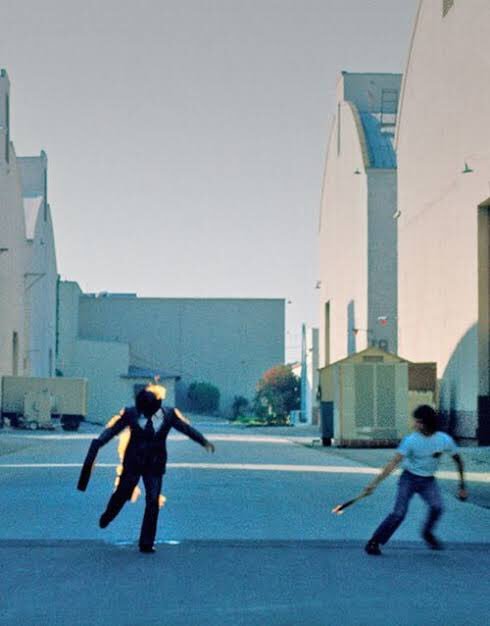
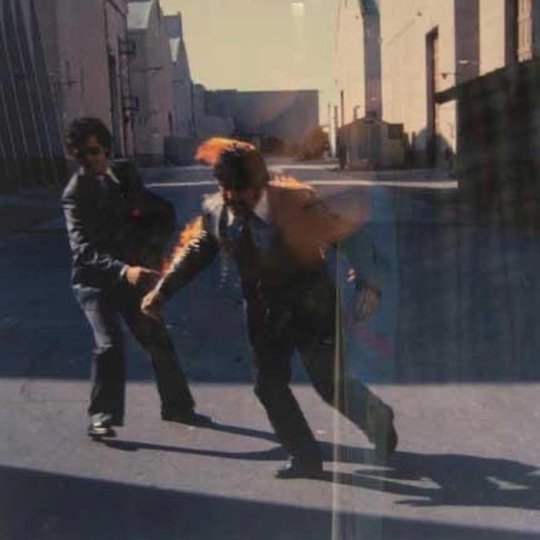
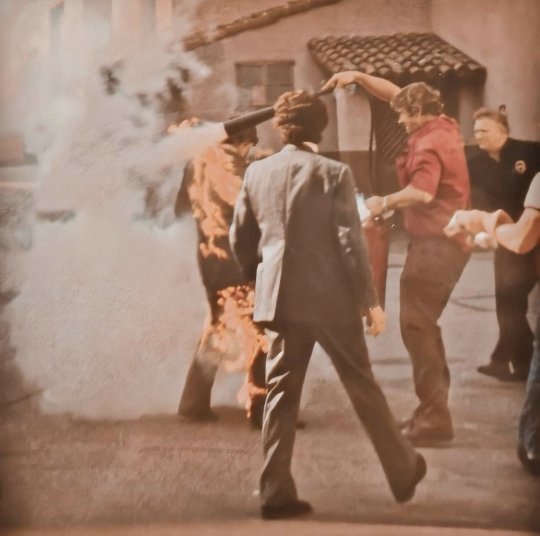
Pink Floyd - Wish You Were Here
📷 Aubrey "po" Powell & Hipgnosis, 1975
#Pink Floyd#Wish You Were Here#Aubrey po Powell#Hipgnosis#1975#70's#70s#behind the scenes#photography#photo#psychedelic rock#psychedelic art
763 notes
·
View notes
Note
Hello, my question is about the Bowers gang and the music. I simply found it curious and fun and since Victor also seems to be a music fan and invited Evelyn next time to listen to music, my question is about her musical tastes, if she has a group. favorite or what genre of music do they listen to or if they have a favorite singer since Belch is a character who is characterized by the fact that he loves Metallica, so he asks me what type of music would each one listen to, Belch, well, he listens to metallica and anthrax (he has a band t-shirt and it appears in a movie if I remember correctly) Victor in one of the chapters says that he likes an Aerosmith song but from there I don't have an idea of the bands or singers I heard, much less Henry or Patrick, I feel Patrick would be the strangest, he doesn't even seem like a person who listened to music or is a fan of someone and Henry doesn't seem that way to me either, and also it's from the 80's so it's even more interesting because I love the music of the 80's. 80s and 70s.
First of all, I absolutely love questions like this! I’ve had the worst week, so this was a very welcome mental vacation. Thank you for this.
Anyway, let’s discuss everyone’s music preferences! I’m just gonna break this down character by character to make my life easier.
— Evelyn
Evelyn likes whatever songs catch her ear on the radio. Music isn’t a huge part of her life, so she doesn’t really have a favorite song or artist. She has songs she likes (a lot of those classic 80s pop hits), sure, but I doubt she knows the names of most of them. So far, I think the only artists I’ve specifically mentioned her liking are Olivia Newton-John, the B-52s (literally just for “Love Shack” probably), and The Beach Boys, but we’ll discover more of her interests later. It’s not a major storyline by any means, but it does get explored.
— Vic
This may be a departure from canon, but in my mind, Victor Criss is an early adopter of the whole 90s grunge aesthetic. Messy hair. Ripped jeans. Flannel. Oversized shirts. Drinking coffee and smoking weed. If this story took place in the 90s, Vic would be all up in that grunge scene. I’m honestly super bummed I couldn’t go that route with him, but mark my words, that boy will go full grunge in college. He will.
Since this story doesn’t take place in the 90s, a lot of people (and by “people” I mean the characters in the story) probably assume Vic’s into heavy metal like Belch, but that’s not necessarily true. See, Vic is very picky about his music, and I don’t mean that in a snobby way at all (although Vic can be a little snobby about it). For him, music is therapy. Vic just wants to get really high, listen to some music, and escape himself for a while. And the wrong kind of music can be painfully grating to him, like to the point where it would cause him intense physical discomfort. That’s why he’s so picky.
So what kind of music does Vic like? I dunno… I could see him being into psychedelic rock, artists like Pink Floyd, Jimi Hendrix, Cream, The Byrds, The Beatles, stuff like that. Vic is very private about his music, though. There’s a reason Christie Gibson can’t seem to figure him out.
It's also a pretty big deal that Vic has invited Evelyn to listen to music with him. Just saying.
— Belch
Next to Victor, Belch is probably the most serious about music. As we all know from the movie, heavy metal is his preference and his passion, but he’s also the kind of guy who can (secretly) appreciate a well-composed song regardless of its genre. That being said, Belch does tend to steer clear of the mainstream pop music scene… unless, of course, Christie Gibson is with him. Yeah, when those two are together, he pretty much lets her play whatever music she wants (because Belch is a good boyfriend).
— Henry
Yeah, I don’t think Henry is that serious about music. He listens to it, sure, everyone does, but it doesn’t impact his life significantly. Despite that, Henry’s tastes are probably very similar to Belch’s, simply because that’s how Henry gets exposed to most of his music: he listens to whatever Belch plays in the car. Apart from that, I could also see him being into bands like Led Zeppelin, Blue Öyster Cult, Deep Purple, Kansas, etc. But would he consider any of them his favorite band? Probably not, because Henry doesn’t have a favorite band.
Honestly, I think Henry has a very negative relationship with music in general. Anything that tries to tap into his emotions or influence his emotions, yeah Henry doesn’t like that. At all. He doesn’t wanna feel things. He doesn’t wanna think about his parents or his childhood. He wants all that shit to stay buried real deep.
— Patrick
For Patrick, all music sounds the same—and by that, I mean it’s all just “noise” to him. He doesn’t connect to it on any level, least of all emotionally.
In Chapter 5 (I think?) we saw Patrick using the radio kind of like a weapon. He purposefully messed with the knob to create the most annoying sounds his possibly could, hoping that it would drive the other guys in the car crazy. And it worked. Belch almost crashed the damn car. That pretty much sums up Patrick’s relationship with music. It’s just something else for him to manipulate and use for his entertainment.
So yeah, I could see Patrick listening to some really weird shit, like music that isn’t really music, but more like a bunch of random creepy/disturbing sounds put together. Patrick’s a weirdo. There’s no way he listens to traditional music.
___________
Okay, that's all I have to say on the subject. Thanks again for this ask! It was a lot of fun to think about. ❤️
#bowers gang#henry bowers#patrick hockstetter#victor criss#belch huggins#it stephen king#it 2017#answered asks#thanks for the ask!#it fanfiction#paper men#ambrossart
20 notes
·
View notes
Text


Today's compilation:
JBO: A Perspective 1988-1998
1998
House / Downtempo / Big Beat / Leftfield / Alternative Dance
Man, this is just such absolutely essential listening if you want a good history lesson in the type of dance music that was especially surging throughout the UK for a certain period of time. JBO: A Perspective 1988-1998 presents a decade-spanning two-disc retrospective on one of the UK's foremost electronic dance labels, Junior Boy's Own, whose tunes reverberated throughout all the acid warehouse parties during the UK's famed second summer of love beginning in 1988, and long thereafter too, following the UK government's crackdown on said parties.
Now, something you have to understand about acid house is that there are essentially two different definitions of it: there's a more sonically literal definition, which describes it as house music that features a liberal use of the Roland TB-303 bass synthesizer sound, and then there's another definition that describes the type of music that was played at the acid warehouse parties themselves, which was actually far more eclectic than just house tunes with TB-303s. And this collection deals with that latter description.
Something else worth knowing here too is that the music that was played at these events sometimes stretched far beyond what we would often consider these days to be dance music. Dance music almost always connotes electronic music that's purely uptempo, but much slower tunes got plenty of burn at these things as well, like Primal Scream's incredible "Loaded," a brimming-with-sunshining-positivity, psychedelically ecstatic classic that's packed with bagpipes and horns and has often been referred to as the acid house generation's own "Sympathy for the Devil." This song, produced by JBO's Andrew Weatherall, was less a result of inspiration being drawn directly from the actual acid house music that had managed to find its way across the pond from Chicago, but was moreso a reflection of an amalgamation of the chill, Balearic vibes that the UK was importing at the time from the party capital of the world—the Spanish island of Ibiza—as well as the Madchester scene, which was seeing indie and alt-rock bands from Manchester like The Stone Roses and Happy Mondays quirkily meld their rock sound with dancier beats, and thus receiving plenty of play at acid house parties too. Oftentimes, whenever I find myself writing about a general history of UK music since the post-punk and new wave days of the late 70s, I talk about what a melting pot it all was, and a dynamic song like "Loaded" serves as just one beautifully prime example of it in action, as it's something that can simultaneously be accurately classified as downtempo, alternative dance, neo-psychedelia, alternative rock, and house. And you could, at one point or another, find any and all of these vibes blaring out of the speakers at an acid house party itself; it's just that "Loaded" is a song that managed to blend them all together so damn perfectly 🤩.
So, ultimately, in addition to "Loaded," what we have here is a chronological slate of tracks that was selected by JBO's Steven Hall, who is humble enough to point out in his liner notes that what he's put together is by no means neither extensive nor authoritative; there was so much more to these acid house years than just what JBO was either putting out themselves or their clan was producing and remixing for others, and as the compilation's title clearly states, this is just merely a perspective on the ten years since the start of the second summer of love.
But then again, by that same token, this 'perspective' is also indispensable from acid house itself too. JBO's role in shaping this 'genre''s overall sounds, development, and history is simply integral and wholly unignorable. Acid house without JBO is sort of like a triple-decker club sandwich without one of its decks; you still have a sandwich at the end of the day, but you sure are missing a whole lot of the stuff that actually makes it what it is in the first place!
And that's borne out by the names you'll find on here that were in the JBO stable, like The Chemical Brothers and Underworld, two of the most important and commercially successful acts in the history of electronic music, period. To his credit, Steven Hall doesn't unload with the obvious choices from either of these groups here; rather, he goes for the more obscure, before both of them started to really gain their respective statuses as icons. From The Chemical Brothers we get a pair of tunes from when they actually called themselves The Dust Brothers, one of which was 1994's "My Mercury Mouth," an expanding breakbeaty tune that really starts to destroy past the two-minute mark, when the guys ladle in all that feelgood synth work 😌.
And with Underworld we get a couple tunes too, including the bubbly and trancey "Rez," plus a solid remix of Björk as well. But in addition to those, we also get one from a prior alias of theirs, with the prominently blues harmonica-laced and bleepy house banger that is "Bigmouth," which they released as Lemon Interupt back in 1992. Pretty great leftfield stuff!
There's also a trio of songs in the beginning of disc one that actually predate the existence of JBO entirely: New Order's "Everything's Gone Green," Mr Fingers' "Can You Feel It," and Pete Wylie's "Sinful," the latter of which's edit I can't seem to find on YouTube 😔. These songs, all unique in their own regard, are ones that inspired JBO to form in the first place, starting out as a clubbing fanzine, and then becoming a party, and then, eventually in 1990, an era-defining record label too.
Didn't even mention the dope remixes of Saint Etienne and My Bloody Valentine by Andrew Weatherall or the remix of U2 by Pete Heller and Terry Farley that are on here, either. Clearly there's a whole lot of gold that's sitting on these two discs, so get yourselves educated on this diverse set of dance and dance-adjacent glory, folks! 😊
Highlights:
CD1:
New Order - "Everything's Gone Green"
Mr Fingers - "Can You Feel It"
Pete Wylie - "Sinful"
Bocca Juniors - "Raise (63 Steps to Heaven) (Heavenly Rap)"
St Etienne - "Only Love Can Break Your Heart (A Mix of Two Halves)"
My Bloody Valentine - "Soon (Andrew Weatherall Mix)"
Primal Scream - "Loaded"
Lemon Interupt - "Bigmouth"
The Chemical Brothers - "Song to the Siren"
One Dove - "Fallen"
CD2:
U2 - "Salome (Zooromancer Mix)"
Underworld - "Rez"
XPress 2 - "Musik X Press"
Björk - "Human Behaviour (Underworld Mix)"
The Chemical Brothers - "My Mercury Mouth"
Black Science Orchestra - "Save Us"
Junior Vasquez - "Get Your Hands Off My Man (Fire Island Dub 4 Junior)"
Ballistic Brothers - "Peckings"
Dylan Rhymes - "Naked & Ashamed"
Underworld - "Moaner"
#house#house music#downtempo#chillout#chill out#big beat#leftfield#leftfield music#left field#left field music#alternative dance#alternative#alternative music#alt#alt dance#alt music#dance#dance music#electronic#electronic music#music#80s#80s music#80's#80's music#90s#90s music#90's#90's music
7 notes
·
View notes
Text
Belladonna of sadness is such a
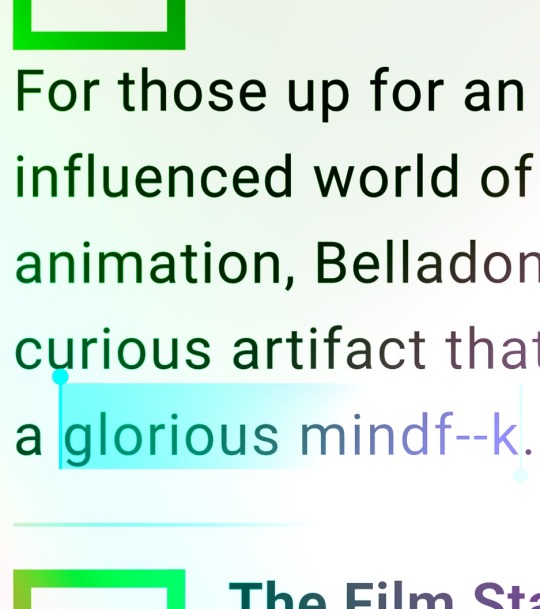

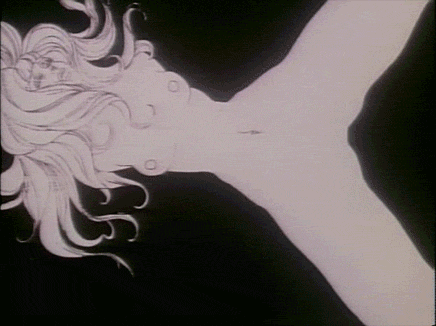
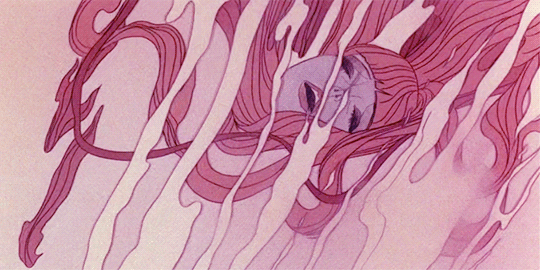

🪧
Kanashimi No Belladonna by Eiichi Yamamoto, 1973
Now that u watched this masterpiece time to throw some light into the ori go back of the story for future ref.
Via EG
The content of Belladonna's story was radically different from any other animated feature up to that point, Japanese or otherwise, but its method of storytelling was just as radical.
It becomes apparent early on when viewing Belladonna of Sadness (Kanashimi No Beradona) that this film is quite unique. Certainly the first, and possibly the only animated film that might be classified in the pinku genre. But even though the film is supposedly animated, nothing seems to be moving at first. You instead see a series of elegantly designed still drawings depicting a harmonious wedding between a peasant couple in 14th century France, as a woman sings her narration in the soulful style of a 70s rock opera.
This is the film's only joyous scene, as moments later the new groom is pleading with the local land baron to reduce the marriage tax he can't afford. The baron instead decides to exercise his "droit de seigneur" with the bride. It is here, several minutes into the film, that full animation is finally used, in order to depict the rape of the virgin bride with metaphorical imagery much more disturbing than what a literal depiction of the same events could provide.
A sign of things to come, as this is only the first in a series of tragic events that push this woman, through desperation, into the world of witchcraft.
Belladonna of Sadness is the product of an animation studio that knew it was doomed, and it shows. Osamu Tezuka's Mushi Productions, which had been so successful producing TV series like Astroboy and Kimba in the 60s, was faltering badly in the early 70s for a variety of reasons related to the oil crisis and Japan's economy in general. But in actuality, Mushi Pro's first venture into feature animation, 1969's 1001 Nights, had been successful enough to spawn a second film in 1970, Cleopatra.
Tezuka, always a trailblazer, had decided that Mushi Pro's feature films would be made to appeal to adult audiences so as to expand the potential for animation as a film medium (whether these first two films succeeded in that regard is debatable). But even though these two features did relatively well at the Japanese box office, the economy was beginning to take a toll on Mushi Pro, and Tezuka refused to downsize. When Tezuka left the studio in 1971 to focus on manga, the remaining employees must have known they were on the road to bankruptcy.
A filmmaker has two choices in a situation like this: cut your losses and go out with a whimper, or pour all your remaining resources and effort into one final, revolutionary labor of love. The folks at Mushi Pro chose the latter option and Belladonna is the result. Predictably, the film had a dreadful theatrical run of only 10 days and Mushi Pro went bankrupt within a few months.
A sort of late 60's psychedelic Art Nouveau revivalism inspired by the likes of Aubrey Beardsley's Victorian parodies, which were likewise inspired by erotic-grotesque shunga prints, thus coming full circle back to Japan.
Belladonna is an adaptation of La Sorcière, the 1862 novelized history of satanism and witchcraft in the late middle ages. The book was written by feminist, freethinker, and Frenchman Jules Michelet, who, like many other post-revolution French intellectuals, was eager to condemn the barbaric European forces of the prior few centuries. In Michelet's story, the practice of witchcraft is not simply the leftover trace of ancient pagan traditions, but an active rebellion against an oppressive church and system of government. While the church expected serfs to suffer and slave away during their time on earth with only the promise of a better afterlife to console them, witchcraft provided a glimpse of happiness in the here and now. Where the church feared the imperfections of nature, witchcraft embraced them. Where the church could only respond to ailments with prayer and holy water, witchcraft offered painkillers and psychoactive potions from datura plants.
According to Michelet, the spirit of rebellion and experimentation found in 14th century witchcraft was a progenitor of the enlightenment values yet to come. Furthermore, this was a movement led by women, those who likely suffered the most at the hands of the church and the feudal system. He insinuates that society's emancipation from oppression is contingent on female liberation and sexual empowerment. It's easy to imagine how these ideas must have resonated with the revolutionary leftist Japanese filmmakers of more than a century later (yes, they were working in animation too).
The film adaptation of La Sorcière is often very faithful to the book, to the point of replicating much of its dialogue. It tells the story of an archetypal witch (unnamed in the book, named Jeanne in the movie) who suffers a series of misfortunes that lead her down the path from being a chaste, obedient peasant's wife, to giving in to her awakened earthly desires, to finally blossoming into the bride of Satan himself.
The process of selling one's soul to the Devil can be interpreted literally or metaphorically, but keep in mind that at least according to Michelet, those who would enter into such a pact in the middle ages presumably believed they were literally sacrificing eternity for just a glimmer of relief from a cruel and bleak life. A pact with Satan was the ultimate act of desperation, not just a casual mistake. On the other hand, none of the "powers" that Jeanne acquires from the Devil require any sort of supernatural explanation. They are simply things that Medieval society has withheld from her: an independent spirit, a liberated sexual libido, communion with nature, an inquisitiveness that allows her to discover the medicinal properties of plants, an air of confidence that enhances her powers of persuasion.
Her relationship with the Devil may be nothing but a psychological coping mechanism for the brutality she suffers.
The content of Belladonna's story was radically different from any other animated feature up to that point, Japanese or otherwise (Ralph Bakshi included), but its method of storytelling was just as radical. The film was designed by illustrator Kuni Fukai, whose drawings may appear to be more Western than Japanese.
But his style seems to be a sort of late 60's psychedelic Art Nouveau revivalism inspired by the likes of Aubrey Beardsley's Victorian parodies, which were likewise inspired by erotic-grotesque shunga prints, thus coming full circle back to Japan. Much of the film features Fukai's drawings directly, with the camera panning over still frames, but the film often transitions seamlessly into full animation thanks to animation director Gisaburo Sugii.
This extra motion tends to happen during the film's numerous sex scenes, but they are generally not visually explicit. Instead, they are animated in a variety of highly stylized expressionistic ways, taking full advantage of animation's ability to caricature form and motion. Because of the film's aesthetic appearance and radical themes, it sometimes appears to be very much a product of its time--the early 70's--which is either good or bad depending on who you ask (the biggest giveaway is its great psychedelic rock / jazz fusion soundtrack which is occasionally reminiscent of J. A. Seazer). But it's important to remember that it is based on source material from over a century before, and that there really are no other comparable movies from that period that would justify an implication that it's at all derivative.
The story of an archetypal witch who suffers a series of misfortunes that lead her down the path from being a chaste, obedient peasant's wife, to giving in to her awakened earthly desires, to finally blossoming into the bride of Satan himself.
Japanese animation was still in its prolonged adolescence in 1973 (you could argue that it still is today). It was only five years earlier that adult political and social themes had begun to make an appearance in anime with Horus, Prince of the Sun. There had not been much experimentation with form or design aside from Tezuka's own independent shorts.
It's closest-related cousin is probably Hiroshi Harada's adaptation of ero-guro manga artist Suehiro Maruo's Midori, similar both for its technique of alternating short scenes of full animation with a "slideshow" of still images, and also for its story of unrelenting cruelty. The film probably has more in common with films from the likes of Koji Wakamatsu than it does with other anime.
Granted, it certainly took longer to make and cost a bit more than a typical pinku film (though it's clearly a low-budget flick), but like many of the best films in that genre, Belladonna manages to promote some form of feminist ideology while simultaneously exploiting the entertainment value of crass misogyny.
#kanashimi no belladonna#belladonna of sadness#internet archive#movies#cult#Japan#women#satanism#witchcraft#misogyny
19 notes
·
View notes
Text
Stranger Things Thoughts
The other half won’t approve, but as your humble narrator has access to binge watching the entirity of ‘Stranger Things’ from start to finish, decided to see what the fuss was all about.
First impressions?
It’s kind of a crossover between the video game Half Life and Goosebumps, and get the suspicion it was aimed at the Buffy The Vampire Slayer and Stephen King fans type target market.
It’s definitely a ‘binge watch’ series - just don’t see how it would have survived as a traditional one hour and one episode a week to hold people’s attention span, as some of the cliffhangers are weaker than train station cafe tea.
Will is really Fiver from the film version of Watership Down. Or Harry Potter’s scar. Just the scar.
Finn Wolfhard and Noah Schnapp were definitely recruited for reasons other than their acting abilities (ie. appealing to Jimmie Savile/Mrs Robinson types), because both are incredibly piss poor. It becomes quiet frightening as the show progresses how often Caleb McLaughlin’s over-the-top angry guy stuff appears to be to overcompensate for both being so insipid. Finn Wolfhard in particular seems to have the acting abilities of a blobfish.
By contrast, Gaten Matarazzo may have a face only a mother could love, but he carries a frighteningly large number of scenes without anyone really noticing it. He’s the Cartman of the gang, but all in a good way. Aside from being the originator of some of their most ‘cunning plans’, he’s the only one who appears to have learned good real life lessons from playing D&D: that is, to succeed against adversity, you need to stick together as a team, each playing to their strengths to compensate for other’s weaknesses.
Millie Bobbie Brown’s acting chops are formidable, but her constant use as a Deus Ex Machina becomes a little wearing after a while. On the other hand, her transformation into David Vanian of the Damned in Season 2 was hilarious.
Natalia Dyer’s jawbone is made from tungsten. There can be no other explanation.
Charlie Heaton is the reincarnation of Déagol from The Lord Of The Rings movies.
That Billy character had the worst case of being closet gay and aggressively in denial about it since Vaas Montenegro in Far Cry 3.
When Will suddened declares that the Big Bad is back in Season 3, right after his fall out with his buds not wanting to be stuck in his D&D timewarp, isn’t it jarring that no one questions it? After all, mega-convenient way of getting the gang back together on his terms, yes?
David Harbour’s Angry Dad routine gets wearing REALLY quickly in season 3.
Why does Winona Ryder’s character give the constant appearence of being a recovering alcoholic?
Steve Harrington’s reaction to Robin admitting she was a lesbian (while turning him down) is ludicrously out of context with what would actually have happened to any woman admitting as much in the 1980s, especially slap bang in the very year the AIDS panic took off in the U.S. (largely after haemophiliac teen Ryan White contracted it via a dodgy blood transfusion, bringing out into the open American’s utterly f**ked up pay-for-blood donation system into question).
Why are none of the kids playing computer games? At all?
The music is meant to be 80s, but they have some real issues with it as much as the supposed 80s clothes and haircuts.
(Here comes the Madame Lee bit, concentrate!)
Season One - It’s Meant To Be 1983, but ....
Jefferson Airplane - 'She Has Funny Cars' and 'White Rabbit'
By the 1980s, Jefferson Airplane were Jefferson Starship, and the drugged out hippies like so many psychedelics and prog rockers had gone down the AOR/Cock Rock route.
By the timeline of 'Stranger Things' the band was falling apart as their brief period of late 70s success burned out - ironically they were to score their biggest hits as plain old post-court case Starship were forced to go even more commercial, with global No.1's with 1985's 'We Build This City (On Rock 'n' Roll)' and 1987's 'Nothing's Gonna Stop Us Now' (the latter the theme song to the hit movie 'Mannaquin') - after which they all but vanished. Jefferson Airplane's back catalogue meanwhile was virtually unsellable at this time.
The inclusion of 'White Rabbit' may have been a scriptwriter's brick joke - as during Eleven's brief runaway in season two, she changes her look to one resembling to a remarkable degree David Vanian of the Damned during the period when, in sheer desperation for a hit outside of the UK, the band did a cover of Jefferson Airplane's most famous track (it flopped, as all covers of this song tend to do).
Toto - Africa
The song which has become an internet meme was released in 1984 ... a year after the events of season one.
The Clash - Should I Stay Or Should I Go?
The other 'theme song' for Season One, played umpteen times during the series. A hit in the summer of 1982, rush released in panic by CBS after the original taster single flopped.
Contrary to historical revision, The Clash were never a major band in the punk era and largely enjoyed only a few minor hits: the major exception was this Mick Jones written track and drummer Topper Headon's 'Rock The Casbah', both for 1982's 'Combat Rock' - when the band had been told by CBS to write a commercially sellable album or have their contract terminated (contrary to the name, it sounds more like a funk record
But by 1983, The Clash were effectively no more: band 'leader' Joe Strummer's ego couldn't handle 'his bass player' and 'his drummer' getting the band's first two truly global selling singles (the two Strummer singles from the album, 'Straight To Hell' and 'Know Your Rights' flopped), and sacked Jones in a fit of pique, after which Headon resigned.
Brotherhood Of Man - Tie A Yellow Ribbon Round The Old Oak Tree
This one is positively embarrassing. Brotherhood Of Man never recorded this song until 2002.
To be fair, a lot of people do get this Brit band (punk's most famous victims: a former Eurovision song contest winner dropped by their record company abruptly after scoring their final No.1 'Figaro' because they were 'old hat') mixed up with Tony Orlando's Dawn, who did the original global hit.
The Bangles - Hazy Shade Of Winter
The Bangles may have covered it in concert, but it was never released on record until 1987.
Foreigner - Waiting For A Girl Like You
From 1981, two years earlier.
Peter Gabriel - Heroes
Oh FFS! Gabriel's murdering of the late David Bowie classic only happened in 2010 for his cover versions album 'Scratch My Back' aka 'Utterly Out Of Ideas'.
Joy Division - Atmosphere
Four years too late, or five years too early, depending on your point of view.
By the timeline of this, nazi bigot Ian Curtis had done the world a favour and hanged himself four years prior (this song was released as a post-suicide cash in, but flopped), and Joy Division had changed name to New Order precisely to cleanse its association with him (ironically they had a mammoth global hit with 'Blue Monday', one of the songs of the 1980s, in 1983, but it never made the show.
A remixed and cleaned up version of 'Atmosphere' was released as a successful standalone single in 1988, as Joy Division's back-catalogue became more critically reappaised with the success of New Order and the moribund far-right no longer being considered a matter of wide scale concern.
Season Two - It's meant to be 1984, but ...
Devo - Whip It
From 1980. Even more ironically, by 1984 the band were virtual pariahs in the United States having 'sold out' their sound for the sake of their New Zealand fanbase (the only place they were ever truly successful). New Zealand wasn't long in following suit ...
Duran Duran - Girls On Film
Arguable. Three years too late - but the song did very heavy rotation in 1983 and 1984 on MTV, bringing them to mass attention, but never became a U.S. hit - it was the follow up, 'Hungry Like The Wolf' which broke the U.S. for them.
The Clash - This Is Radio Clash
Flop single from 1981, except in Sweden where it reached No.9 - a year later.
Shock Therepy - Can Do What I Want
One year too early.
Fad Gadget - Back To Nature
Again, one year too early.
John Carpenter - The Bank Robbery
One of the most infamous show howlers. The song comes from the 1981 movie 'Escape From New York' ... except it never made it to the soundtrack and indeed remained unknown to the general public until making it on a collection of 21st century 'lost' soundtrack tunes.
The best known example of the show's producers self-indulging rather than keeping things on theme.
Season Three - It's meant to be 1985, but ...
Stray Cats - Rock This Town
Not only was it four years too late, but the band had split two years earlier and were by that time in the zeitgeist regarded as something of a joke - an attempted reunion in 1986 ended in near empty halls and humiliation all round, as by this time more visually appealing bands like King Kurt and The Cramps had taken up whatever rockabilly audience remained.
Cutting Crew - (I Just) Died In Your Arms Tonight
This walking abortion of a song from a walking abortion of a band encapsulated everything bland and faux about the 1980s, but it wasn't until the summer of 1986 it appeared.
Go-Go's - Get Up And Go
From 1984 - by which time the Go-Go's had messily folded and were already forgotten. By the following year, the success of Belinda Carlisle further hastened their erasure from the zeitgeist, and it’s only in recent years their ‘legacy’ has been reappraised.
Foreigner - Cold As Ice
Those involved in the show seem to have a major hard on for Foreigner, but putting this song, which sound dated enough upon its release in 1977 - never mind 1985 - was beyond belief.
Trevor Jones - The Pod Dance
Taken from 1983's 'The Dark Crystal' soundtrack - just about the only time having a tune vastly out of place song worked, during the painful to watch sequence where Will attempts to get two of his friends to play a session of Dungeons & Dragons, unable to accept that their interests have moved on to girls - Will's timing being especially poor as both are suffering crises in their respective puppy love lives.
Will - already silly looking enough with his pudding bowl haircut - appears utterly ludicrous to the point of disturbing in a purple wizard outfit complete with hat and starry cloak (he looks like the sort of children's entertainer that gets arrested on child molestation charges), trying aggressively to get his friends to care less.
You'd have to go back to the film 'Ghostworld' for a better sequence of watching childhood friends drifting apart, and 'Stranger Things' succeeded in five minutes what it took a whole film to do, and the choice of music was perfect.
By contrast ...
Dame Vera Lynn - We'll Meet Again One of the songs of World War Two, especially to armed forces personnel being sent across the world with the very real prospect of never seeing their loved ones again, it's often been used ironically (eg. the multiple nuclear bomb ending of the film 'Dr Strangelove'), it was also the first single to feature a synthesiser (yes, really!)
Its use at the end of the episode where evil Billy has escaped back to the spider monster thing's lair, knowing now Eleven and the rest of the meddling kids are onto them, is jarring.
Possum River - Stand Up and Meet Your Brother
From 1971 - complete self indulgence. Didn't even go with the carnival sequence.
Yello - Goldrush
A full year too early.
Hmmmmm, onward to Season Four, which is all about The Ginger One, well it will need to have a bloody amazing script to pull it off, as she was someone only stomachable in small doses at the best of times ...
#stranger things#finn wolfhard#noah schnapp#gaten matarazzo#caleb mclaughlin#millie bobby brown#natalie dyer#charlie heaton
7 notes
·
View notes
Text
Brian Eno
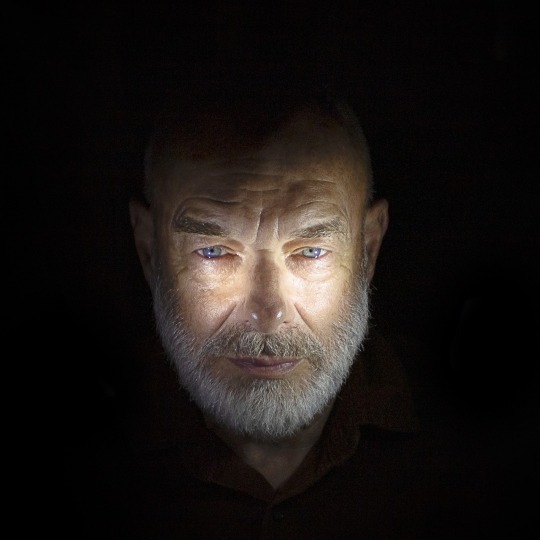
Brian Peter George St. John le Baptiste de la Salle Eno
Almost no one uses the full name of this outstanding musician. Many people don’t even know that the currently popular musical direction “Ambient” was presented to the World by this very person. Although he started out as a typical British rocker, which, however, very soon he got tired of.
Today is May 15th — Brian Eno’s birthday — he turned 76 years old. He is almost the same age as Jean Michel Jarre, and took up experimental electronic music in the same era as him — at the turn of the 60s and 70s. Brian Eno’s first musical refuge was the group Roxy Music, in which he was responsible for keyboard parts and special effects, but his vision was not fully combined with the trend of the group’s development, and after the second RM album, Brian Eno went out and began a solo career.
The first two solo albums were to some extent still in tune with Roxy Music — also songs, also Rock, albeit strange. But starting with 1975’s “Another Green World” Eno began to delve into experimentation to its fullest depth. In fact, back in 1975, he recorded the experimental psychedelic album “Evening Star” with Robert Fripp (“King Crimson”), which has already become the defining vector of almost all of his subsequent work. Further, he only confirmed his commitment to experimental and ambient electronica. And the song inclusions were relegated to the level of collaboration with other musicians, whom Eno produced in large numbers. Among his wards at various times were U2, Talking Heads and David Byrne, David Bowie, Robert Fripp, Elvis Costello, John Cale, Nico, Paul Simon, «Звуки Му», Genesis, Cluster, Slowdive, Coldplay, Natalie Imbruglia and many others — the list can be very long. As is the incredibly extensive discography of Brian Eno himself.
It’s safe to say that the number of full-length albums that he has released under his own name, or had a significant hand in as a key writer/co-writer, if not already in the one hundred, is rapidly approaching that.
Brian Eno’s musical style was adopted by many prominent representatives of the electronic scene. Among them is Jean Michel Jarre, who in 1990 actually recorded a remake of Brian Eno’s 1985 album Thursday Afternoon — we know this work as “Waiting for Cousteau”, although not everyone knows that the original idea for such music belonged to Eno.
Eno was the first to come up with the concept of self-developing music, which could be released as a web application, and when launched, independently generated new melodic and environmental elements each time, but strictly in the style specified by the author. Later, this concept was largely repeated by Jean Michel Jarre, who released the EON web application.
Brian Eno is distinguished by his amazing creative tirelessness, and still regularly releases new albums, several releases a year, but at the same time there is absolutely no feeling that the author has gone into self-citation.
Brian Eno on Youtube Music: https://music.youtube.com/channel/UCoWPCwCsQmBwoXBCL_laaIw
One of Brian Eno’s key, and one might say classic, albums is Apollo, a soundtrack commissioned by NASA to score a film about the manned mission to the Moon. If you ask yourself what exactly Eno himself meant by the term “Ambient” (this concept has mutated greatly over the decades), then the Apollo album is the best answer to such a question.
1 note
·
View note
Text
Population II – “Pourquoi qu’on dort pas” (Song Premiere)
Today I’m excited to bring everyone the latest single from three-piece rock band, Population II, called “Pourquoi qu’on dort pas.” On this electric new track, the band delivers a heavy, psychedelic rock-infused sound with feverish funk rhythms, a hint of jazz philosophy, a burst of early punk energy, and a love of minor scales that harkens back to the roots of heavy metal. I was able to catch up with the band for a brief interview below.
The new track, “Pourquoi qu’on dort pas” is a bit more aggressive than we’ve seen in the past two singles, could you talk a bit about how the song came together?
We find it’s a very nuanced track as the aggressive and dark intro and end leave room for passages of light in the verses. The song came through our usual way of improvising. Pierre-Luc and Tristan were grooving together on the verses and Seb stuck that intense intro and conclusion with wonderful bass Melodies. The title is a direct nod to “Why aren’t we sleeping,” from Kevin Ayers/Soft Machine.
”Pourquoi qu’on dort pas” translates to “Why aren’t we sleeping?”
We took the riff from that and changed some notes and it started sounding like Black Sabbath. Our friend Colin Fisher then added some pretty tasty counter melodies and lead lines to the track.
You’ve about how the band’s music is inspired by various musical scenes of the 60’s and 70’s. What is it that you find so appealing about the music from that era?
We think it’s the organic nature of that music. Most of what inspires us are from German music from the late 60’s to 80’s, the Canterbury scene and various punk scenes. We want to continue to push the envelope and aren’t aiming at being a retro revival band but we love those past years scenes for its authenticity (that is still present to this day, but mostly in different forms than a live band). We want the album to sounds as much as us as possible so most of what you’re hearing on our records is us three playing in room and we sprinkle other layers on top. While these artistic decisions might not give us the trendiest overly produced pop banger it makes us who we are. Friends expressing themselves in a communal way.
With the release of your sophomore album, Électrons libres du québec coming this Friday, what’s next for the band?
Population II all over the world! we haven’t toured much in general these last years (haha). Another album and EP is already on the way. And mostly, make something new for us, everybody, to bring joy and hopefully inspire a few to pick up some instruments. Everyone can do it!
---
Please consider becoming a member so we can keep bringing you stories like this one.
◎ https://chorus.fm/features/population-ii-pourquoi-quon-dort-pas-song-premiere/
0 notes
Text
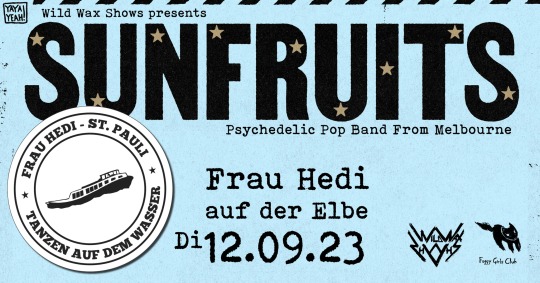
Di., 12.9.2023, 19:00 Uhr:
SUNFRUITS (AU)
MS Hedi, Hamburg
Sunfruits are a psychedelic pop band from Melbourne. Founded by Winter McQuin, their members include Evie Vlah, Imogen Cygler, Elena Jones and Gene Argiro. Sunfruits live shows revive the 60s psychedelic sounds and visuals with their very own modern 70s rock spin, blending their own twist of modern psychedelia and harmonious pop.
Sunfruits have been making waves around Melbourne and the Australian music scene for the past 3 years with their environmentally conscious and politically aware lyricism, paired with their contemporary psychedelic pop sound. On 2021 release, ‘Certified Remixes’ saw the band collaborate with Traffik Island, Hachiku and Candy on three remixes of previously released tracks ‘Above The Clouds’, ‘Mushroom Kingdom’ and ‘Whatever You Want’. Releasing two 7”s and an EP during their time working with Third Eye Stimuli Records and recently Flightless Records (Distro), these releases all received high praise from Triple J, Clash Magazine, Beat Magazine, Tone Deaf, New Commute and more.
Sunfruits have collaborated with brands including Bonsoy on their 2020 release double single ‘Mushroom Kingdom / Bonsoy’ as well as Green Music Australia on their 2020 debut EP ‘Certified Organic’. These releases saw the talented live group appear at festivals including NYE On The Hill, Ok Motels, Euroa Music Festival, Brunswick Music Festival and supporting acts including Mildlife, Nice Biscuit, Gabriella Cohen, Good Morning, Cable Ties, as well as multiple headline tours of the east coast of Australia. Their most recent ‘Made To Love’ sees Sunfruits showcase an exciting new direction and their most definitive work to date. Garnering acclaim from The Guardian, Tone Deaf, Pilerats, New Commute, triple j, PBS, RRR and more, this track sets the tone for what is still to come, we can expect to see the band reach new heights.
1 note
·
View note
Text
Queen O' (Broken) Hearts by The Foundlings is a fun throw back to 70's classic rock
youtube
While indie rock is all about innovation, it's also about nostalgia and revising what was popular in the past. Still as we move through 2023, bands are doing alot of genre-blending. By experimenting with combining different styles and influences to create something unique, there’s alot of risk but sometimes for maximum rewards.
According to Ken Dunckley of The Foundlings he desc rides his sound…
"If Eddie Van Halen joined the Allman Brothers to form a Beatle tribute band, it would sound like this..."
Queen O' (Broken) Hearts by The Foundlings is a fun throw back to classic rock mixed with a touch of the 70’s. I can’t help but hear elements of London post-punk in the single like that influenced by The Psychedelic Furs or other acts that spawned the British post -punk scene. It’s a pretty wild mix of influences and a fun track to learn about.
Music Review by Jacqueline Jax
The Foundlings - Queen O' (Broken) Hearts
Music Genre: Rock
Vibe: Upbeat and hard rockin'
Located in: Long Island, NY
Sounds like: Someone described our tune as such: "If Eddie Van Halen joined the Allman Brothers to form a Beatle tribute band, it would sound like this..."
https://youtu.be/w0iHpNSiTvc
Social Links & Website:
https://www.youtube.com/@thefoundlings555
https://www.facebook.com/thefoundlingsUSA
https://open.spotify.com/artist/5jKBApmw49IEQ5TJwbyKtg
https://thefoundlingsband.net/home
0 notes
Photo
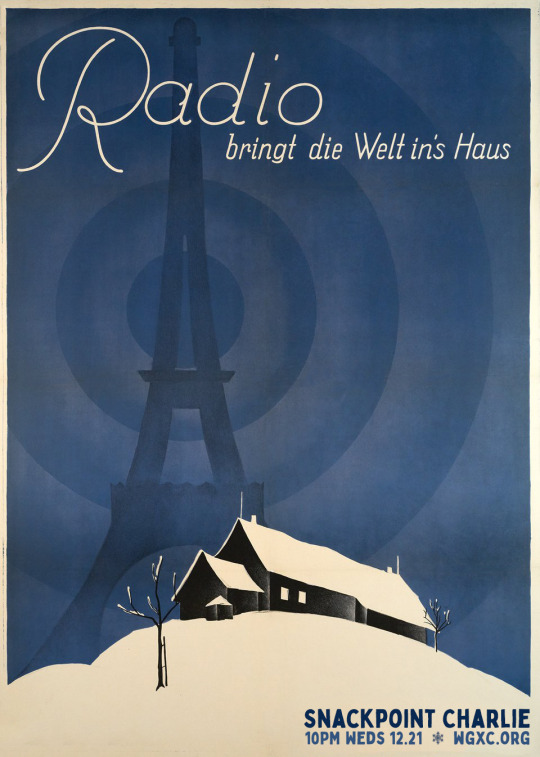
As the storm approaches and you brace yourself for the deluge, take refuge in the warm dry radio waves of Snackpoint Charlie. From a tawdry melange of unfamiliar sounds to a plush duvet of aural bliss, I got your happy holidays right here, pal. 10pm-midnight 2022.12.21 on WGXC and what do you know, right here as well. Includes one actual Christmas song! You're welcome.
Snackpoint Charlie - Transmission 104 - 2022.12.21
PLAYLIST
https://wavefarm.org/wf/archive/rb5jnd
1) K.J. Yesudas & K.S. Chitra - “Gopika Vasantham”
2) Mina - “Insieme”
https://youtu.be/59Uf9q1oEjw
3) Orchestre Poly-Rythmo De Cotonou Dahomey - “Gnonnou Ho” from LE SATO
https://www.discogs.com/master/2176687-Orchestre-Poly-Rythmo-De-Cotonou-Dahomey-Le-Sato
4) Mdou Moctar - “Ibitilan” from NIGER EP VOL. 2
https://mdoumoctar.bandcamp.com/album/niger-ep-vol-2
(underbed throughout)
Pinchas Gurevich - “Abindleluft” and “Black Body Radiation”
5) Zuhura Swaleh with Maulidi Musical Party - “Safari” from JINO LA PEMBE
https://www.discogs.com/release/4867874-Zuhura-Swaleh-With-Maulidi-Musical-Party-Jino-La-Pembe
6) Pippo Franco - “Chì Chì Chì Cò Cò Cò”
https://www.discogs.com/master/378637-Pippo-Franco-Ch%C3%AC-Ch%C3%AC-Ch%C3%AC-C%C3%B2-C%C3%B2-C%C3%B2
7) Death Is Not The End - excerpt from ALL BAD BOY & ALL GOOD GIRL: MANCHESTER STREET SOUL SOUNDTAPES, 1988-1996
https://deathisnot.bandcamp.com/album/all-bad-boy-all-good-girl-manchester-street-soul-soundtapes-1988-1996
8) M. Ashraf (feat. Nahid Akhtar) - “Dilbar Dilbara” from THE SOUND OF WONDER! THE FIRST WAVE OF PLUGGED-IN POP AT THE PAKISTANI PICTURE HOUSE
https://www.discogs.com/master/139891-Various-The-Sound-Of-Wonder
9) Zangoleah - “Uncle Chainmaker” from PERSIAN UNDERGROUND - GARAGE ROCK, BEAT AND PSYCHEDELIC SOUNDS FROM THE IRANIAN 60'S & 70'S SCENE
https://www.discogs.com/master/400575-Various-Persian-Underground-Garage-Rock-Beat-And-Psychedelic-Sounds-From-The-Iranian-60s-70s-Scene
https://wetransfer.com/downloads/c118c4ee6d42a6b9f7fb4bd16d948f0f20221218085558/4740d7
10) Wild Carnation - “New York Woman” from CUT PIECES: TRIBUTE TO YOKO ONO
https://www.discogs.com/release/11084528-Various-Cut-Pieces-A-Tribute-To-Yoko-Ono
11) Jenny Mae & Azalia Snail - “Gem” from JENNY MAE & AZALIA SNAIL
https://www.discogs.com/release/6277385-Jenny-Mae-Azalia-Snail-Jenny-Mae-Azalia-Snail
https://www.martinradio.com/2019/10/jenny-mae-azalia-snail-1997-indie-rock.html
12) Lotte Lenya - “Seeräuber-Jenny (Pirate Jenny)” from THE LOTTE LENYA ALBUM
https://www.discogs.com/master/582176-Lotte-Lenya-The-Lotte-Lenya-Album
13) (Unknown) - “You Poisoned My Soul” from BONE MUSIC
https://x-rayaudio.squarespace.com/poison
14) Mitsuko Nemoto - “Cosmos Elegy” from LONGING FOR THE SHADOW: RYŪKŌKA RECORDINGS, 1921-1939
https://deathisnot.bandcamp.com/album/longing-for-the-shadow-ry-k-ka-recordings-1921-1939
15) ថាសចម្រៀង បទប្របកៃ ប្របកៃកាព្យជុឌុចទី២ នាយពៅ និង នាងសាអ៊ុំ (Neay Pov and Neang Sa Om) - “(Cambodian Folk Song)” from KHMER RECORD ARCHIVES
https://www.youtube.com/watch?v=G09hXtOvc-I
16) Circuit des Yeux - “Sculpting the Exodus” from SUNSET POEM - REIMAGINED BY CLAIRE ROUSAY
https://circuitdesyeux.bandcamp.com/album/sunset-poem-claire-rousay-remixes
17) Pepino Pascual - “Passant pel tub” from TU
https://www.viasona.cat/grup/pepino-pascual/tu
18) Nawa - “Mowashah Al Refku Be Maftoon” from ANCIENT SUFI INVOCATIONS AND FORGOTTEN SONGS FROM ALEPPO
https://www.discogs.com/master/756279-Nawa-Ancient-Sufi-Invocations-Forgotten-Songs-From-Aleppo
19) David Levy - “December 8, 2022, Clouds Over Ashokan Reservoir”
20) Masahiko Togashi with Don Cherry & Charlie Haden - “Words of Wind - Part 2” from SONG OF SOIL
https://wewantsounds.bandcamp.com/merch/masahiko-togashi-with-don-cherry-charlie-haden-song-of-soil-lp-special-edition-with-8pp-colour-booklet-and-2pp-insert
21) Yanti Bersaudara - “Silent Night Holy Night” from THE YANTI SISTERS [CHRISTMAS EP]
https://www.discogs.com/The-Yanti-Sisters-Marys-Boy-Child/release/8426202
http://madrotter-treasure-hunt.blogspot.com/2020/12/the-yanti-sisters-yanti-bersaudara.html
#notyourdadsworldmusic#snackpointcharliewgxc#snackpointcharlieradio#radioforopenears#hellsdonuthouse#communityradio#freeformradio#outernational#hudsonvalley#globalmusic#worldmusic#globalbeat#wgxcradio#hudsonny#wgxc
0 notes
Text
Narrative Post #1
During this first week, I underwent listening to multiple artists and studying their techniques. Since my ability to identify notes by ear helps a lot when listening, I can translate what I hear to what I play. Going into to detail of what I've studied, I took a step back in my tastes. A while ago (by that I mean a couple of months) I listed to a lot of psychedelic rock from the 60s and 70s. Consisting of Jimi Hendrix, early Pink Floyd, The Beatles, Cream, etc. I mainly looked at the work of Hendrix, being one of the most unique and looked at styles in all of guitar history. Mainly his use of the guitar, many said he used as more than just an instrument. His heavy use of feedback and modulation left a heavy impact on his listeners. Even birthing some of the earliest metal techniques. Another great 70's band I'd like to mention would be Pink Floyd, I will mainly be focusing on their second and most well-known guitarist, David Gilmour. Gilmour's style diverges from the blues scene that was very prominent at the time. His style is very soothing at times yet also very aggressive. As is his voice. Examples of an aggressive yet soft playing style would be in the song "Echoes" from their 1971 release "Meddle". I just mentioned blue and forgot to bring up one of the many kings of blues, B.B. King. His work starting as early as 1951 has influenced many throughout the years. Personally, I'm a big fan of his late 60's and early 70's work. "Chains and Things" is just an utter masterpiece. Since I am Latin-American, I'm exposed to a lot of Latino music. Most of which I've grown very fond of. I've been exposed to a lot of Peruvian sounds since both of my parents were born and raised in Peru. I've tried learning some classic Latin-type techniques on guitar, taking on from Spanish Flamenco style playing. Andean playing styles have also been a big inspiration since, of course, its deep connection with my Peruvian roots. Returning to the rock of things, I love I some 70's funk. And when you mention 70's funk, you are bound the hear the words "Funkadelic's" and "Parliament" pop up. Two of the most popular funk god-like bands to roam this earth. They've gone through a handful of guitarists in their time, one of the most notable was Eddie Hazel. One of Hazel's most outstanding works was on Funkadelic's 3rd studio album, "Maggot Brain" (bottom right in the image above). Where the title track of said album has an eight-minute guitar solo, which served as a showcase of Hazel's amazing talent at the time. Another great, 6+ member band of the 70's where Bob Marley and The Wailers. Not only were their songs outstanding,, but the solos that appear mainly on the live album "Babylon By Bus". With The Wailers switching artists constantly except for about 6 or 7 or so, this recording had two lead guitarists, Al Anderson and Junior Marvin. Both of which deliver marvelous solos on the performances of "Rebel Music (3 O'clock Roadblock)" and "Concrete Jungle". Skipping forward a few generations, we reach the early 2000's. Introducing one of my personal favorite modern prog-rock bands, The Mars Volta. Guitarists Omar Rodriguez-Lopez is just an absolute master of his craft (I'm actually listening to them as of writing this :). Rodriguez-Lopez's use of effects has given him a reputation similar to that of Soda Stereo's Gustavo Cerati. A great example on his use of effect would be on the song "Cassandra Gemini: Faminepulse" off their 2005 release "Frances the Mute". Specifically at the 2:56 mark of the track is where he gives a great example of noise manipulation using a simple analog delay. Aight, that's enough studying for now. Join me in the second narrative post to see me include this into my practice routine! Goodbye for now!
1 note
·
View note
Video
youtube
Zior - Entrance Of The Devil / Every Inch A Man (1971)
http://www.vintageprog.com/classic70srock/zior.htm
#Zior#Entrance Of The Devil#Every Inch A Man#1971#fuzz psych rock bands#70's psychedelic rock scene#England#obscure 70's psych/hard rock bands#personal#video#kb-p2730
8 notes
·
View notes
Audio
‘Golf Girl’ by Caravan, from ‘In the Land of Grey and Pink’
#Caravan#In the Land of Grey and Pink#Golf Girl#1971#70's#70s#Canterbury Scene#Progressive Rock#Psychedelic Rock
2 notes
·
View notes
Photo

Janita “Jenny” Haan_Babe Ruth
#Janita Jenny Haan#Babe Ruth#70's Heavy Rock Scene#psychedelic rock#Astounding Rock Musicians#female rock n roll musicians#Goddess#hard rock
5 notes
·
View notes
Link
The Cosmic Dead are an experimental psychedelic space rock quartet from Glasgow, Scotland. Formed in 2010, they have released four studio albums and several other releases as of 2015. The Exalted King is their 2nd album,which is released July 23, 2012
Tracklist:
1.The Exalted King
2.Anatta
3.Anaphora


http://riffipedia.wikia.com/wiki/The_Cosmic_Dead
@kb-p2730
#The Cosmic Dead#Psychedelic space rock#doom metal#heavy rock#70's Hard/PsychRock#Uncle Acid and the Deadbeats#rock n roll#Gnod#Mars Red Sky#Electric Moon#Stoned Jesus#The Exalted King#2012#Full Length#albums#vinyls#rock#00's Rock Scene#Glasgow#Scotland#enjoy it#@kb-p2730
9 notes
·
View notes
Note
I have POSSIBLE news regarding Harry’s new music video!!
I’ve summarised a casting call email but there was no direct mention of H so this shouldn’t be taken as fact. I just want to see what everyone thinks because honestly I’m convinced it is him and we will new be getting new music in February/March.
It’s a casting call for a “Major Male Pop Artist Music Video”.
The production company is Prettybird and will be directed by Bradley + Pablo who directed Watermelon Sugar.
Fittings for the actors is next week but there were no date included for filming but I imagine it’ll be in February.
It will be shot in London.
The title is DUVET
This could be a shooting title but since we don’t know any songs from HS3 I don’t know if there is any need to film under a different name.
This is the casting brief;
“We want a mixture of ethnicities, genders, sexual orientation and body types. We want to create a feeling of timelessness with the cast and art direction - so if someone has a face from the 60s we wanna see it! We are looking for people with warm, kind, bubbly, loving, sex positive, tender, carefree energy. Particularly for the more intimate scenes. It’s really important we create the right atmosphere on set so we want people that bring this, feel comfortable and make others feel comfortable.”
The acting leads are two women (25-30 natural casual beauty and natural wild eyed beauty), a real couple (male and female, sex positive, 20s), and “Artists Date” (male retro model type 20s).
Secondly roles are for a real dummer, bassist, keyboard player (all 25-30 60’s/70’s psychedelic rock energy)
There are other roles for scenes that look to be an art gallery, a street scene, a group bed scene, and an authentic Italian restaurant.
The tea is piping hot today ☕️
739 notes
·
View notes